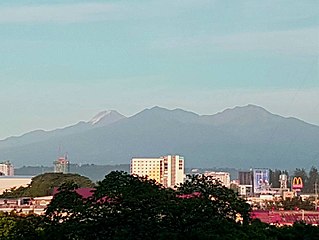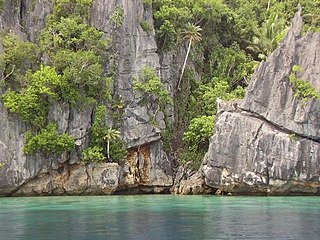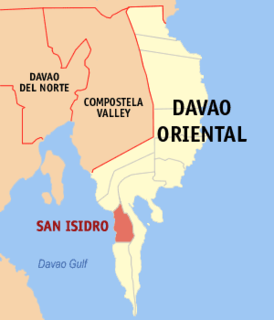Kalagan may refer to:
| This disambiguation page lists articles associated with the title Kalagan. If an internal link led you here, you may wish to change the link to point directly to the intended article. |
Kalagan may refer to:
| This disambiguation page lists articles associated with the title Kalagan. If an internal link led you here, you may wish to change the link to point directly to the intended article. |

Mount Apo, also known locally as Apo Sandawa, is a large solfataric, active stratovolcano on the island of Mindanao, Philippines. With an elevation of 2,954 meters (9,692 ft) above sea level, it is the highest mountain in the Philippine Archipelago and is located between Davao City and Davao del Sur province in Region XI and Cotabato in Region XII. The peak overlooks Davao City 45 kilometers (28 mi) to the northeast, Digos 25 kilometers (16 mi) to the southeast, and Kidapawan 20 kilometers (12 mi) to the west. Mount Apo is a protected area and a Natural Park of the Philippines.

Davao del Sur is a province in the Philippines located in the Davao Region in Mindanao. Its capital and largest city is Digos. The province is bounded by Davao del Norte to the north; Davao Occidental to the south-east; North Cotabato and Sultan Kudarat to the west; South Cotabato and Sarangani to the south-west ; and the Davao Gulf to the east.

Davao Region, formerly called Southern Mindanao, is an administrative region in the Philippines, designated as Region XI. It is situated at the southeastern portion of Mindanao, comprising five provinces: Davao de Oro, Davao del Norte, Davao del Sur, Davao Oriental, and Davao Occidental.

Davao de Oro, formerly known as Compostela Valley or its short form ComVal, is a province in the Philippines located in the Davao Region in Mindanao. The province used to be part of Davao del Norte until it was made independent in 1998.

Caraga, officially the Caraga Administrative Region or simply known as Caraga Region and designated as Region XIII, is an administrative region in the Philippines occupying the northeastern section of the island of Mindanao. The Caraga Region was created through Republic Act No. 7901 on February 23, 1995. The region comprises five provinces: Agusan del Norte, Agusan del Sur, Dinagat Islands, Surigao del Norte, and Surigao del Sur; six cities: Bayugan, Bislig, Butuan, Cabadbaran, Surigao and Tandag; 67 municipalities and 1,311 barangays. Butuan is the regional administrative center.

San Isidro, officially the Municipality of San Isidro, is a 4th class municipality in the province of Davao Oriental, Philippines. According to the 2015 census, it has a population of 36,032 people.
Interdental consonants are produced by placing the tip of the tongue between the upper and lower front teeth. This differs from dental consonants, which are articulated with the tongue against the back of the upper incisors.
The Central Philippine languages are the most geographically widespread demonstrated group of languages in the Philippines, being spoken in southern Luzon, Visayas, Mindanao, and Sulu. They are also the most populous, including Tagalog, Bikol, and the major Visayan languages Cebuano, Hiligaynon, Waray, Kinaray-a, and Tausug, with some forty languages altogether.

Garcia Hernandez, officially the Municipality of Garcia Hernandez,, is a 4th class municipality in the province of Bohol, Philippines. According to the 2015 census, it has a population of 24,194 people.

Santa Maria, officially the Municipality of Santa Maria, is a 2nd class municipality in the province of Davao Occidental, Philippines. According to the 2015 census, it has a population of 53,671 people.

Banaybanay, officially the Municipality of Banaybanay, is a 2nd class municipality in the Province of Davao Oriental, Philippines. According to the 2015 census, it has a population of 41,117 people.

Lupon, officially the Municipality of Lupon, is a 1st class municipality in the province of Davao Oriental, Philippines. According to the 2015 census, it has a population of 65,785 people.

Mati, officially the City of Mati and also referred to as Mati City, is a 5th class city and the capital of the province of Davao Oriental, Philippines. According to the 2015 census, it has a population of 141,141 people.

Qalağan, also known as Qalaqan or Kalagan, is a village and municipality in the Khachmaz Rayon of Azerbaijan. It has a population of 977. The municipality consists of the villages of Qalağan, Keymərəz, and Hacılar.
The Mansakan languages are a group of Austronesian languages spoken in the Philippines. Davawenyo is the principal native language of the Davao region; however, there is a high degree of bilingualism in Cebuano among their speakers.
Kalagan is an Austronesian dialect cluster of the Davao Region of Mindanao in the Philippines. It is also spoken in a few parts of Caraga, still in Mindanao.
Mandaya is an Austronesian language of Mindanao in the Philippines. It may be intelligible with Mansaka.
The Kagan people, are the ethnic group of the southeastern part of the Philippines known as Davao Region. They are one of the Muslim minority groups in Mindanao and belong to the 13 Muslim Moro tribes of the Bangsamoro family. They are thought to be one of the various groups of lowland Filipinos who came to the islands from Asia's southwestern mainland several thousand years ago.

Kallehgan is a village in Rameshk Rural District, Chah Dadkhoda District, Qaleh Ganj County, Kerman Province, Iran. At the 2006 census, its population was 41, in 11 families.
Sinigapuna is a Filipino rice dish cooked with turmeric and other spices. It originates from Kalagan people of the Caraga and Davao Regions of Mindanao. It is similar to the Maranao kuning.